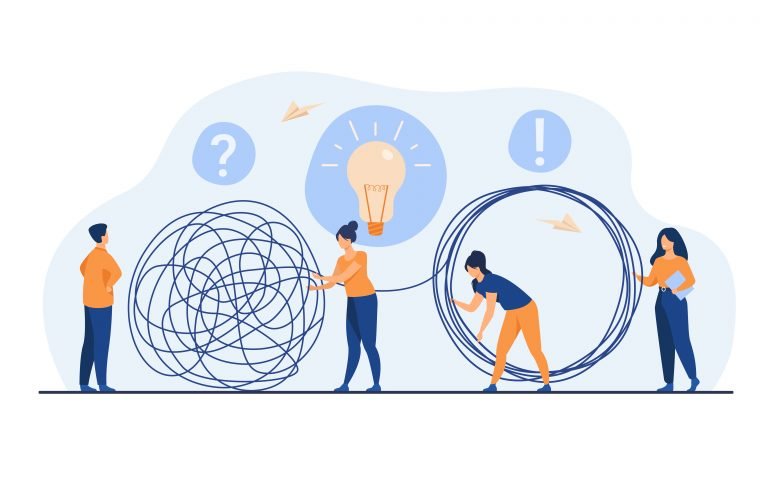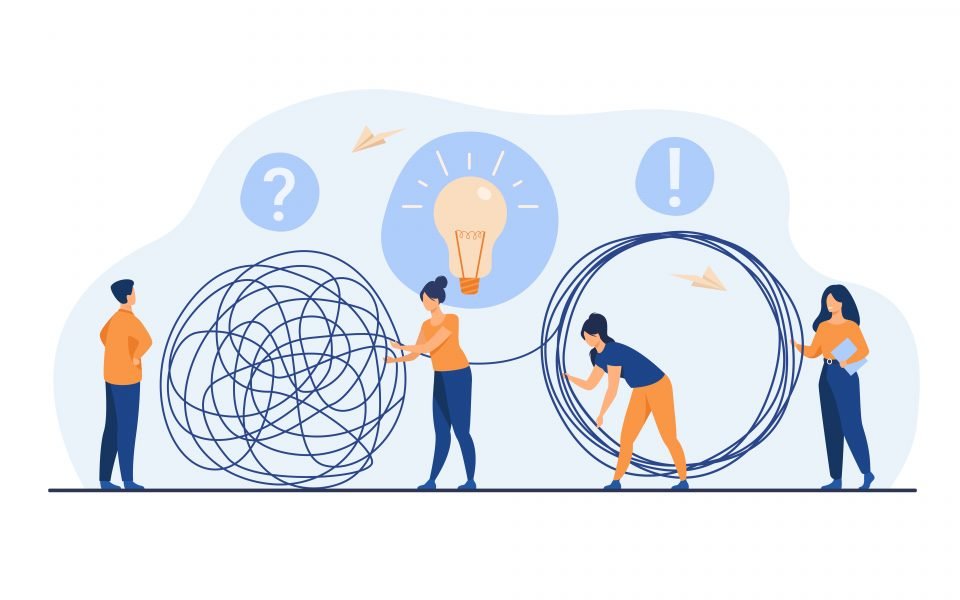This article is written specifically for devising a strategy as you work with deaf individuals but many of these principles can be applied to any accessibility strategy.
The other day I was talking with a team member, who is Deaf, about what is needed to achieve successful accessibility. They said the first thing needed is awareness. I found that interesting but not surprising. Everything we do in life requires starting out with awareness. As an infant, we enjoy our siblings playing with us on the floor and at a moment’s notice, they are off-to-trot playing somewhere else. It’s then that we become aware that those other limbs of ours can be a useful thing. And as we all know, that’s where we begin to take flight.

1. Recognize the need for a strategy. One of the most important things your company can do is to build a strategy around accessibility. Oftentimes in working with companies, they consider accessibility as on the fly, in the moment, and sometimes even an emergency type of decision. Through our discussions, they realize that with their current lack of strategy, they will always struggle to effectively meet the needs of their current and potential deaf employees, consumers, clients, communities, etc. That means almost without fail, a demographic will not be included, the struggle to provide will always be there, costs will be much more than expected, and/or their business will be susceptible to lawsuits. Strategizing is the cheapest and most effective way to make sure successful accessibility happens.
So how do you create an accessibility strategy tailored to meet the needs of the deaf? First, we need to learn what it is the deaf need (and learn a little bit of the why). Then we can explore the possible places to start, after which you can begin to create your strategy. And as with everything, implementation is the number one key to a successful accessibility strategy.
2. Determine what they need. Regardless if the deaf person uses ASL or doesn’t, they need effective communication. It will look different for each person. We don’t give a pair of glasses with a standard one-size-fits-all prescription to every person who has trouble seeing. The glasses are tailored individually. For the sake of this article, we will list common needs but we’d encourage you to ask deaf individuals what they need (and want!) and listen, with the intent to follow through.
Captions: Captions for those who have a command of English is a primary need. For those whose language was not English first, captions are still needed but are a support to their primary need. You can caption your materials in-house or out-source them – don’t rely on auto-captions. Technology is getting better but if you only knew what comes across the screen sometimes (oh my!), you’d make sure it’s actually done right. So forgo the trauma and put effort into the captions. If you’re not aware, the ADA requires that businesses provide captions to their video content. For a great layman’s terms understanding of caption requirements, check out this article by the National Association of the Deaf.
Audio Descriptive Transcriptions: Some audio content contains more than Mr. Stein’s monotone flat-lining emotion of “Bueller, Bueller… Bueller”. Audio descriptive transcriptions offer greater detail than what is read in a written monotone caption, whether it be more emotion, a lack of emotion or other audio. They give clues to the character voices, the background noises, the inflections, the music intensity, the robust sounds that actually make the communications (words or sounds) interesting and meaningful. Without descriptions such as these, the deaf are left unaware.
ASL Interpreter: The primary language for millions of Deaf people is American Sign Language (not English .. or English captions). Interpreters are a vital part of a Deaf person’s ability to communicate with the world. Urt – stop, turn around, let’s look at that another way. A Deaf person can communicate with the world just fine on their own. But most of the world doesn’t sign, and therefore wouldn’t understand them. I hope you see what I’m saying. We should never discount the Deaf person’s ability to communicate nor the need for interpreters. Interpreters are critical in education, doctor’s offices, the workforce, entertainment, etc. How do you find an interpreter? You can do a search for ‘ASL interpreting agency’ or contact your state’s Deaf commission or center for a directory of registered / certified interpreters or use RID’s search tools to find a nationally certified interpreter.
Fixed ASL Translations: Any content that is in a ‘fixed’ format, meaning any video content or written content like documents, forms, manuals, website materials, etc., is best provided in a fixed ASL format. This means that the content (video or written) goes through a translation process and is then filmed and edited, resulting in an equivalent ASL video that matches the intent and look of the original content. The completed ASL product can be used over and over, from person to person, is on hand, available and prepared in a way that fits the original intent and communications. So why is this important (even when you have an interpreter on site)? Let’s consider a video to start. Mime along if you’d like. If you are watching the interpreter your eyes are not on the video. When your eyes are on the video, you are unable to watch the interpreter. You miss out on video content or you miss out on verbal content – constantly. This is setting the deaf person up for failure. We call this ‘the event of the toggle head’. Now let’s consider human nature without any true fault to the human as we talk about interpreters and fixed content. This can be any content, video or written. An interpreter is human and therefore may not be able to be present when needed (earthquake, sick, accident), showed up but had a fight with their spouse that morning (trying to focus but with life on their minds), perhaps they had a long day interpreting (keeping up but tired and hungry and forgot the shopping list at home), don’t forget the skill level of one interpreter is not the same skill level as another (I’m longer, you’re stronger, who knows), etc. Putting fixed content through a translation process eliminates all of that. When the translation and production process is vigorous and includes strong skill sets throughout, the deaf person doesn’t have to suffer because of the human side of life. They can be independent and experience the same content as their hearing peers. This is also a very cost effective way to provide accessible content.
Other Needs: There are other needs like using CART (real-time transcriptions) or facing the deaf person if they can read lips. But don’t forget to consider things like how to communicate with a deaf person effectively during an evacuation or best practices for an interview or how to create effective and accessible engagement on social media or what about the eye breaks (oh, the much needed eye breaks!). There is so much more to consider but the key is to recognize there are appropriate and effective solutions to any situation – learning what is the best fit or not for each is the question. We will go back to the beginning and say ASK, LISTEN and FOLLOW THROUGH. Don’t be afraid of the ask. Figuring out next steps and budgets and all that follows is the easy part.
3. Determine steps to strategy implementation. All of the above costs money. It’s the nature of human needs. So how do you strategize the needs? If you are unsure or need assistance, hire a consultant who specializes in accessibility strategies, communications, and implementations. They will be there to ask all the questions, determine the best course of action and help you with your follow through.
But here is a quick 10,000 foot strategy guide:
First, consider the content that needs to be captioned. If the content is not all available to the audience right now, then first caption what is – start with the newest and work your way back through your available content (or focus on the content that is most used). Then put the rest in the pipeline and budget the caption needs based on your releases. Don’t release something and then say it’s in the process of being captioned. (A big no-no.) Release a captioned version at the start.
Second, and it’s not really second in terms of timing – just in terms of information, consider your business. What is it that you offer? If you are a museum or aquarium or the like, consider investing into fixed ASL translations. These are a one-time fixed cost and have long-term benefits. What if your company has deaf employees? Yes, you need to provide interpreters but figure out the information or communication that needs to be interpreted. Is it something you can bring an interpreter in by the need or should you consider hiring a full-time interpreter? Hiring a full-time interpreter is double awesome and in some places it is double needed. But determining if an interpreter is needed full-time or not will require a culmination of conversation, position needs, communication requirements, etc. In most companies, regardless of the interpreter situation, there is still a need for fixed ASL translations. Consider your company manuals, mandatory training videos and materials, and onboarding content. If you are customer facing, there is much value in providing fixed ASL translations for your educational materials and even your website content. If you provide anything that requires understanding of audio content, consider the audio descriptive transcriptions. Again, look at the content that is current and/or most widely used. Start there and work strategically (or backwards).
Third, your accessibility strategy should be on the forefront of your mind at every turn. No project or communication should be released without considering the actual needs of those who communicate differently than you. Accessibility needs to be budgeted so that implementation can happen, because when implementation happens, inclusivity finally comes to fruition. A little word to the wise: If you want to know what salt poured on an open wound feels like, it’s releasing something not accessible and communicating ‘we’ll do that later’. Yeah, avoid this at all cost.
Lastly, for any of the work you do, invest in quality work. Qualified interpreters, quality fixed ASL translation production (not the same process as on-site interpreters), quality captions, etc. At the end of the day, the quality you invest will reflect on your company and you’ll see not only your bottomline grow but the community you serve. Make it count.
Working with reputable companies like Access Simplified is key to successful accessibility strategy implementation. The Access Simplified team is primarily made up of Deaf professionals specializing in consultations and fixed ASL translations, and can work within your budget.
